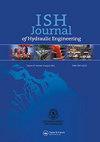Fuzzy cluster analysis and decision-making algorithms for optimal water distribution network design
引用次数: 0
Abstract
ABSTRACT Three objectives, maximization of resilience, minimization of cost, and minimization of leakages, were considered in the Water Distribution Network (WDN) framework for a benchmark problem of Hanoi WDN and a real-world problem, Pamapur WDN, Telangana, India. Non-dominated Sorting Genetic Algorithm-II (NSGA-II) is employed to generate Non-dominated WDN Strategies (NWDNS). In order to simplify the decision-making process of engineers, Fuzzy Cluster Analysis (FCA) is employed to categorize NWDNS into groups. An optimum number of clusters are based on the Elbow method. Representative NWDNS, i.e. RNWDNS for each sub-cluster, is based on the membership values. Ranking of RNWDNS is performed with two decision-making algorithms, namely, Preference Ranking Organization METHod for Enrichment of Evaluations-2 (PROMETHEE-2) and VlseKriterijumska Optimizacija I Kompromisno Resenje (VIKOR). The additive ranking rule is also applied to obtain ranks in a group decision-making environment to arrive at the optimal WDN. It is observed that 1020 NWDNSH (H represents Hanoi) generated for the Hanoi are optimally classified into 18 clusters based on the Elbow method, and A13 representing RNWDNSH 37 (cost, resilience, and leakages, respectively, are 7.8818 × 106 $, 0.3194, 0.2024 × 10−3 m3/s) is preferable, respectively. Whereas 272 NWDNSP (P represents Pamapur) generated for the Pamapur are classified into 9 clusters where S6 representing RNWDNSP 203 (cost, resilience, and leakages, respectively, are 3.5159 × 106 Rs., 0.8367, 0.5317 × 10−3 m3/s) is preferred, respectively. The present study facilitated seamless integration of NSGA-II (generation of Pareto front), FCA (reducing to manageable set) and MCDM methods (to rank the reduced manageable set) in a robust manner. GRAPHICAL ABSTRACT供水管网优化设计的模糊聚类分析及决策算法
摘要:在配水网络(WDN)框架中,针对河内配水网络的基准问题和印度特伦甘纳邦帕玛普尔配水网络的现实问题,考虑了三个目标:弹性最大化、成本最小化和泄漏最小化。采用非支配排序遗传算法- ii (NSGA-II)生成非支配WDN策略(NWDNS)。为了简化工程师的决策过程,采用模糊聚类分析(FCA)对nwdn进行分组。基于肘部法得到最佳簇数。代表性NWDNS,即每个子集群的RNWDNS,是基于成员值的。采用两种决策算法对RNWDNS进行排序,即promeee -2和VlseKriterijumska Optimizacija I Kompromisno Resenje (VIKOR)。在群体决策环境下,应用加性排序规则进行排序,得到最优WDN。研究发现,基于肘部法,河内市生成的1020个NWDNSH (H代表河内市)被最优地划分为18个簇,其中A13代表RNWDNSH 37(成本、弹性和泄漏分别为7.8818 × 106 $、0.3194、0.2024 × 10−3 m3/s)更优。而为Pamapur生成的272个NWDNSP (P代表Pamapur)被分为9个簇,其中S6代表RNWDNSP 203(成本、弹性和泄漏分别为3.5159 × 106 Rs、0.8367、0.5317 × 10−3 m3/s)是首选。本研究以稳健的方式促进了NSGA-II (Pareto front的生成)、FCA(减少到可管理集)和MCDM方法(对减少的可管理集进行排序)的无缝集成。图形抽象
本文章由计算机程序翻译,如有差异,请以英文原文为准。
求助全文
约1分钟内获得全文
求助全文
来源期刊

ISH Journal of Hydraulic Engineering
Engineering-Civil and Structural Engineering
CiteScore
4.30
自引率
0.00%
发文量
59
 求助内容:
求助内容: 应助结果提醒方式:
应助结果提醒方式:


